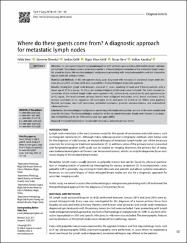| dc.contributor.author | Dere, Yelda | |
| dc.contributor.author | Ekmekci, Sümeyye | |
| dc.contributor.author | Çelik, Serkan | |
| dc.contributor.author | Çelik, Özgür İlhan | |
| dc.contributor.author | Dere, Özcan | |
| dc.contributor.author | Karakuş, Volkan | |
| dc.date.accessioned | 2020-11-20T14:50:04Z | |
| dc.date.available | 2020-11-20T14:50:04Z | |
| dc.date.issued | 2018 | |
| dc.identifier.issn | 2564-6850 | |
| dc.identifier.issn | 2564-7032 | |
| dc.identifier.uri | https://doi.org/10.5152/turkjsurg.2018.3856 | |
| dc.identifier.uri | https://app.trdizin.gov.tr//makale/TWprd05EQXhNUT09 | |
| dc.identifier.uri | https://hdl.handle.net/20.500.12809/1447 | |
| dc.description | 0000-0003-0238-2236; 0000-0001-9178-2850 | en_US |
| dc.description | WOS: 000440304500012 | en_US |
| dc.description | PubMed ID: 30023978 | en_US |
| dc.description.abstract | Objective: In cases presenting with lymphadenopathies (LAP) without a primary focus detected by simple radiological methods, the primary tumor can be diagnosed by a histopathological evaluation of the metastatic lymph nodes. We aimed to discuss the nonhematological malignancies presenting with lymphadenopathies and the histopathological results for primary tumors. Material and Methods: In this retrospective study, cases diagnosed with metastasis in excisional lymph nodes between January 2013 and June 2016 were assessed for a histopathological diagnostic approach Results: Among 632 lymph node biopsies, a total of 21 cases, involving 12 male and 9 female patients with a mean age of 57.23 y (range, 33-92 y), of nonhematological solid tumors were included. The most common localizations of the involved lymph nodes were inguinal (n=8), axillary (n=6), cervical (n=4), and supraclavicular (n=3) region. The most common primary tumors were malignant melanoma (n=6), breast carcinoma (n=4), ovarian carcinoma (n=2), squamous cell carcinoma (n=2), and germ cell tumor (n=2). Others were papillary thyroid carcinoma, renal cell carcinoma, urothelial carcinoma, prostate adenocarcinoma, and endometrial adenocarcinoma. Conclusion: Nonhematological malignancies presenting with lymphadenopathies are one of the most complicated cases for clinicians. The histopathological evaluation of the excisional metastatic lymph node biopsies is an important method because of cost effectiveness and easy applicability. | en_US |
| dc.item-language.iso | eng | en_US |
| dc.publisher | Aves | en_US |
| dc.item-rights | info:eu-repo/semantics/openAccess | en_US |
| dc.subject | Immunohistochemistry | en_US |
| dc.subject | Lymph Node Metastasis | en_US |
| dc.subject | Unknown Primary Tumor | en_US |
| dc.title | Where do these guests come from? A diagnostic approach for metastatic lymph nodes | en_US |
| dc.item-type | article | en_US |
| dc.contributor.department | MÜ, Tıp Fakültesi, Cerrahi Tıp Bilimleri Bölümü | en_US |
| dc.contributor.institutionauthor | Dere, Yelda | |
| dc.contributor.institutionauthor | Ekmekci, Sümeyye | |
| dc.contributor.institutionauthor | Çelik, Serkan | |
| dc.contributor.institutionauthor | Çelik, Özgür İlhan | |
| dc.contributor.institutionauthor | Dere, Özcan | |
| dc.contributor.institutionauthor | Karakuş, Volkan | |
| dc.identifier.doi | 10.5152/turkjsurg.2018.3856 | |
| dc.identifier.volume | 34 | en_US |
| dc.identifier.issue | 2 | en_US |
| dc.identifier.startpage | 131 | en_US |
| dc.identifier.endpage | 136 | en_US |
| dc.relation.journal | Turkish Journal of Surgery | en_US |
| dc.relation.publicationcategory | Makale - Uluslararası Hakemli Dergi - Kurum Öğretim Elemanı | en_US |


















